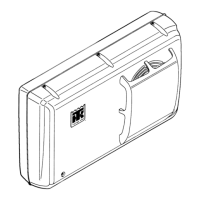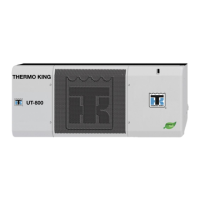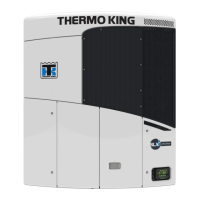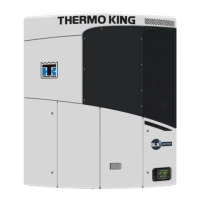Refrigeration Maintenance and Service Operations
136
Adding Compressor Oil
1. With the unit off, remove the cap from oil
pressure fitting.
2. Use a commercial hand pump, force oil in
through the oil pressure fitting. Slowly add
oil. Add Polyol Ester oil only! Refer to Tool
Catalog.
3. When the compressor oil sight glass is 1/2 to
3/4 full, remove hand pump and replace the
cap on the oil pressure.
4. Start and operate the unit on Cool using the
Capacity 100% test from the manual Function
Test menu of the controller. Recheck the oil
level and refrigerant charge level before
returning the unit to service.
Removing Excess Compressor Oil
1. Install an access valve actuator on the oil
pressure fitting.
2. Operate the unit on Cool using the Capacity
100% test from the manual Function Test
menu of the controller. Remove oil while
watching the level in the compressor sight
glass.
NOTE: Heavy foaming of the oil as it leaves
the compressor may indicate an excess of
refrigerant in the oil. Remove the access
valve actuator and operate the system for 15
minutes to ensure warm sump. Then recheck
the oil level.
3. When the compressor oil sight glass is 1/2 to
3/4 full, remove hand pump and replace the
cap on the oil pressure.
4. Operate the unit and recheck the oil level
before returning the unit to service.
Refrigerant Charge
NOTE: CSR units do not have sight glasses
installed in the refrigeration system. Therefore,
the refrigerant charge level can not be visually
inspected
Perform a controller pre-trip test to determine that
a the unit contains an adequate charge of
refrigerant for cooling. If the unit passes the
pre-trip test, the refrigerant charge is OK.
A pre-trip test should be performed during pre-trip
and routine maintenance inspections. A low
charge of refrigerant will cause the container
temperature to rise due to the lack of liquid
refrigerant at the expansion valve even though the
unit is operating in a cooling mode.
NOTE: See “Receiver Tank Sight Glass” under
“Unit Instruments” in the Operating
Instructions chapter for information about
checking the moisture indicator in the sight
glass.
Unit Refrigerant Charge:
• CSR20SL: 3.5Kg (7.7 lb.) R-404A (Standard
Receiver).
• CSR40SL and CSR40: 3.6Kg (8.0 lb.)
R-404A (Standard Receiver).
• Water-Cooled Condenser-Receiver Tank
Option: 1.0 Kg (2.2 lb.) Additional R-404A
NOTE: Inspect the unit for refrigerant leaks
with a reliable leak detector if the unit is
suspected of being low on R-404A charge.
Refrigerant Leak Test
Procedure
Use a reliable Halogen leak detector such as
model H10G (refer to Tool Catalog), to leak test
the refrigeration system. Inspect carefully for
signs of compressor oil leakage which is the first
sign of a leak in the refrigeration system.
NOTE: Due to environmental concerns and
personal safety, the use of a Halide torch is no
longer recommended.
If refrigerant has leaked or been removed from the
unit:
1. Check entire system for possible component
damage and refrigerant oil loss.
2. Attach gauge manifold set (refer to “Gauge
Manifold Set Attachment and Purging” for
proper procedures).
CAUTION: When adding R-404A to the
unit, be careful not to OVERCHARGE
the unit.
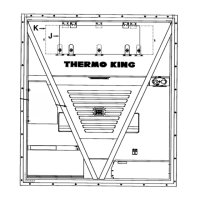
